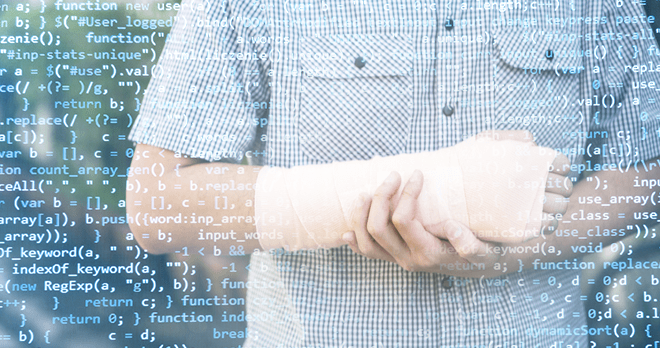Artificial Intelligence: the future of diagnosing wrist fractures?

A group of researchers, led by Nils Hendrix of the Jeroen Bosch Hospital in the Netherlands, has published a study demonstrating that an automated AI technique can be used to detect patterns in X-ray imaging which would not be readily apparent to the human eye.
Their report, Development and Validation of a Convolutional Neural Network for Automated Detection of Scaphoid Fractures on Conventional Radiographs, showed the AI tool, when tested on 190 X-rays and compared with interpretations of 11 radiologists, was able to achieve a sensitivity of 78% for spotting fractures and a positive predictive value of 83%.
This research is particularly important as previous attempts to automate diagnoses using this technique (by convolutional neural network) have fallen short in replicating human interpretation. This is thought to have been overcome in this study by using larger datasets and improved algorithms.
The report authors believe the AI tool could be developed for use in practice, the aim being to reduce the risk of a scaphoid fracture being inadvertently missed, speed up diagnosis, and allow earlier treatment for those where a fracture is identified.
Why is this so important?
Scaphoid fractures typically arise when people try to break a fall by putting their hands out in front of them, and is estimated to make up 7% of all skeletal fractures. Despite being a relatively common injury it can be hard to diagnose. Conventional X-ray imaging is inherently restricted by factors such as wrist position and the overlapping of other bones, thereby obscuring a clear view of any fracture. For this reason it is thought that scaphoid fractures are radiologically occult, i.e not visible on X-ray, in around 7%–21% of cases; though some studies report it as high as 50%.
Timely diagnosis is critical for appropriate management of a fracture, and to ensure an optimal recovery. There is a relatively short window for the fracture to heal in a satisfactory position, failing which there can be long term or even permanent injury. Non-union of the scaphoid fracture is estimated to occur in around 12% of patients, if left untreated. This can lead to the need for additional invasive surgery for repositioning or fixation, and can cause permanent pain, stiffness, sensitivity to temperatures and restricted movement, or functional loss. It can also cause osteoarthritis or avascular necrosis (the death of bone tissue due to a lack of blood supply).
The effects of a missed scaphoid injury can therefore have a significant impact on a person’s life. It can restrict the ability to cook, drive, care for others, play sport, or the ability to do your job, especially if it affects your dominant hand.
Due to the potential impact of a missed scaphoid fracture, some clinicians err on the side of caution and treat patients as if they have a scaphoid fracture even when they aren’t sure it’s there. Whilst this is understandable in some ways, particularly given that treatment is usually conservative, this still has adverse impact in terms of a patient potentially being unduly restricted for no good reason and undergoing further imaging/follow up, all of which carries a cost to the NHS and potentially to them personally if they are unable to work or care for children in the interim, for example.
Whilst this is unlikely to be rolled out in your local hospital any time soon, this is a significant advancement in healthcare AI and one which bodes well for the future.
Looking ahead, the researchers plan to build on the findings to date, and to refine their AI tool for enhanced identification of scaphoid fractures and beyond, to other fracture types.
Mr David Shewring, a Consultant Hand Surgeon based at University Hospital of Wales, Cardiff & Vale University Heath Board and past President of the British Society for Surgery of the Hand, who we regularly instruct as an independent expert on orthopaedic injuries, gave us his thoughts on the tech:
“This is, of course, a positive development. Anything that can help increase diagnostic accuracy is to be welcomed.
Sadly, however, it is unlikely to eradicate or even to significantly reduce the incidence of clinical negligence cases due to missed scaphoid fractures. The vast majority of these cases occur when the patient is inadequately assessed in the emergency department and then either inadequate radiographs or no radiographs at all are taken. Even a highly trained computer will not be able to diagnose a fracture, even if present, for such cases!
The danger is that this will be seen as some sort of panacea for such problems and even an excuse for poor clinical practice.
The key will always be thorough training for clinical staff and a conscientious, methodical and meticulous approach to diagnosis and management, which we must all strive for.”
I have acted for many people who have suffered injuries and financial hardship as a result of a scaphoid fracture being overlooked and it is hard to overstate the impact a misdiagnosed scaphoid injury can have on someone, particularly where it affects their ability to work, care for children or to participate in a sport they love. A tool which could improve the accuracy or speed of diagnosis would be of huge benefit to patients and clinicians alike.
Better recognition of scaphoid fractures would likely save the NHS a huge sum of money in the longer term as well as improving the outcomes for patients, and this tool could be an important part of the solution.